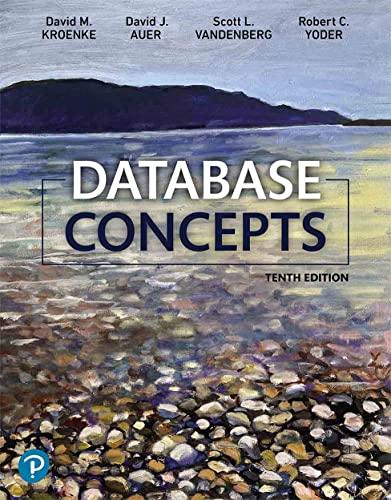Question
I need help with this Java Program, I need both parts done program and the extra credit one. Please provide all the code and tell
I need help with this Java Program, I need both parts done program and the extra credit one.
Please provide all the code and tell me how to compile it. thank you


WeightedGraphInterface.java
//---------------------------------------------------------------------------- // WeightedGraphInterface.java by Dale/Joyce/Weems Chapter 9 // // Interface for a class that implements a directed graph with weighted edges. // Vertices are objects of class T and can be marked as having been visited. // Edge weights are integers. // Equivalence of vertices is determined by the vertices' equals method. // // General precondition: Except for the addVertex and hasVertex methods, // any vertex passed as an argument to a method is in this graph. //----------------------------------------------------------------------------
package ch09.graphs;
import ch05.queues.*;
public interface WeightedGraphInterface
boolean isFull(); // Returns true if this graph is full; otherwise, returns false. void addVertex(T vertex); // Preconditions: This graph is not full. // Vertex is not already in this graph. // Vertex is not null. // // Adds vertex to this graph.
boolean hasVertex(T vertex); // Returns true if this graph contains vertex; otherwise, returns false.
void addEdge(T fromVertex, T toVertex, int weight); // Adds an edge with the specified weight from fromVertex to toVertex.
int weightIs(T fromVertex, T toVertex); // If edge from fromVertex to toVertex exists, returns the weight of edge; // otherwise, returns a special null-edge value.
UnboundedQueueInterface
void clearMarks(); // Sets marks for all vertices to false.
void markVertex(T vertex); // Sets mark for vertex to true.
boolean isMarked(T vertex); // Returns true if vertex is marked; otherwise, returns false. T getUnmarked(); // Returns an unmarked vertex if any exist; otherwise, returns null.
int getNumVertices();
String getToVertexNotVisited(WeightedGraphInterface
UnboundedQueueInterface
UnboundedQueueInterface
}
WeightedGraph.java
// Incomplete version
//---------------------------------------------------------------------------- // WeightedGraph.java by Dale/Joyce/Weems Chapter 9 // // Implements a directed graph with weighted edges. // Vertices are objects of class T and can be marked as having been visited. // Edge weights are integers. // Equivalence of vertices is determined by the vertices' equals method. // // General precondition: Except for the addVertex and hasVertex methods, // any vertex passed as an argument to a method is in this graph. //----------------------------------------------------------------------------
package graphs;
import queues.*;
public class WeightedGraph
public WeightedGraph() // Instantiates a graph with capacity DEFCAP vertices. { numVertices = 0; maxVertices = DEFCAP; vertices = (T[]) new Object[DEFCAP]; marks = new boolean[DEFCAP]; edges = new int[DEFCAP][DEFCAP]; } public WeightedGraph(int maxV) // Instantiates a graph with capacity maxV. { numVertices = 0; maxVertices = maxV; vertices = (T[]) new Object[maxV]; marks = new boolean[maxV]; edges = new int[maxV][maxV]; }
public boolean isEmpty() // Returns true if this graph is empty; otherwise, returns false. { return (numVertices == 0); }
public boolean isFull() // Returns true if this graph is full; otherwise, returns false. { return (numVertices == maxVertices); }
public void addVertex(T vertex) // Preconditions: This graph is not full. // Vertex is not already in this graph. // Vertex is not null. // // Adds vertex to this graph. { vertices[numVertices] = vertex; for (int index = 0; index
public boolean hasVertex(T vertex) // Returns true if this graph contains vertex; otherwise, returns false. { for (int i = 0; i
} private int indexIs(T vertex) // Returns the index of vertex in vertices. { int index = 0; while (!vertex.equals(vertices[index])) index++; return index; }
public void addEdge(T fromVertex, T toVertex, int weight) // Adds an edge with the specified weight from fromVertex to toVertex. { int row; int column; row = indexIs(fromVertex); column = indexIs(toVertex); edges[row][column] = weight; }
public int weightIs(T fromVertex, T toVertex) // If edge from fromVertex to toVertex exists, returns the weight of edge; // otherwise, returns a special null-edge value. { int row; int column; row = indexIs(fromVertex); column = indexIs(toVertex); return edges[row][column]; }
public UnboundedQueueInterface public void clearMarks() // Sets marks for all vertices to false. { for (int i = 0; i public void markVertex(T vertex) // Sets mark for vertex to true. { int index; index = indexIs(vertex); marks[index] = true; } public boolean isMarked(T vertex) // Returns true if vertex is marked; otherwise, returns false. { int index; index = indexIs(vertex); return(marks[index]); } public T getUnmarked() // Returns an unmarked vertex if any exist; otherwise, returns null. { boolean found = false; int index = 0; while ((index
Step by Step Solution
There are 3 Steps involved in it
Step: 1

Get Instant Access to Expert-Tailored Solutions
See step-by-step solutions with expert insights and AI powered tools for academic success
Step: 2

Step: 3

Ace Your Homework with AI
Get the answers you need in no time with our AI-driven, step-by-step assistance
Get Started


